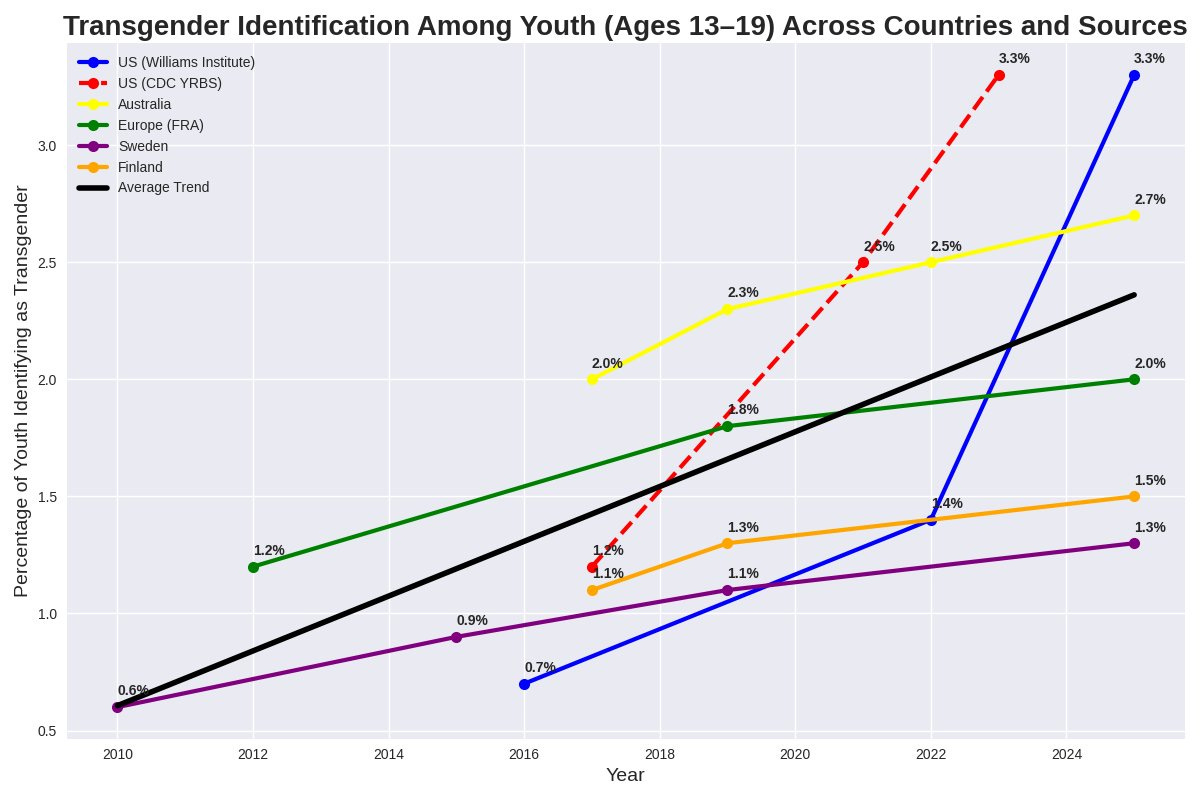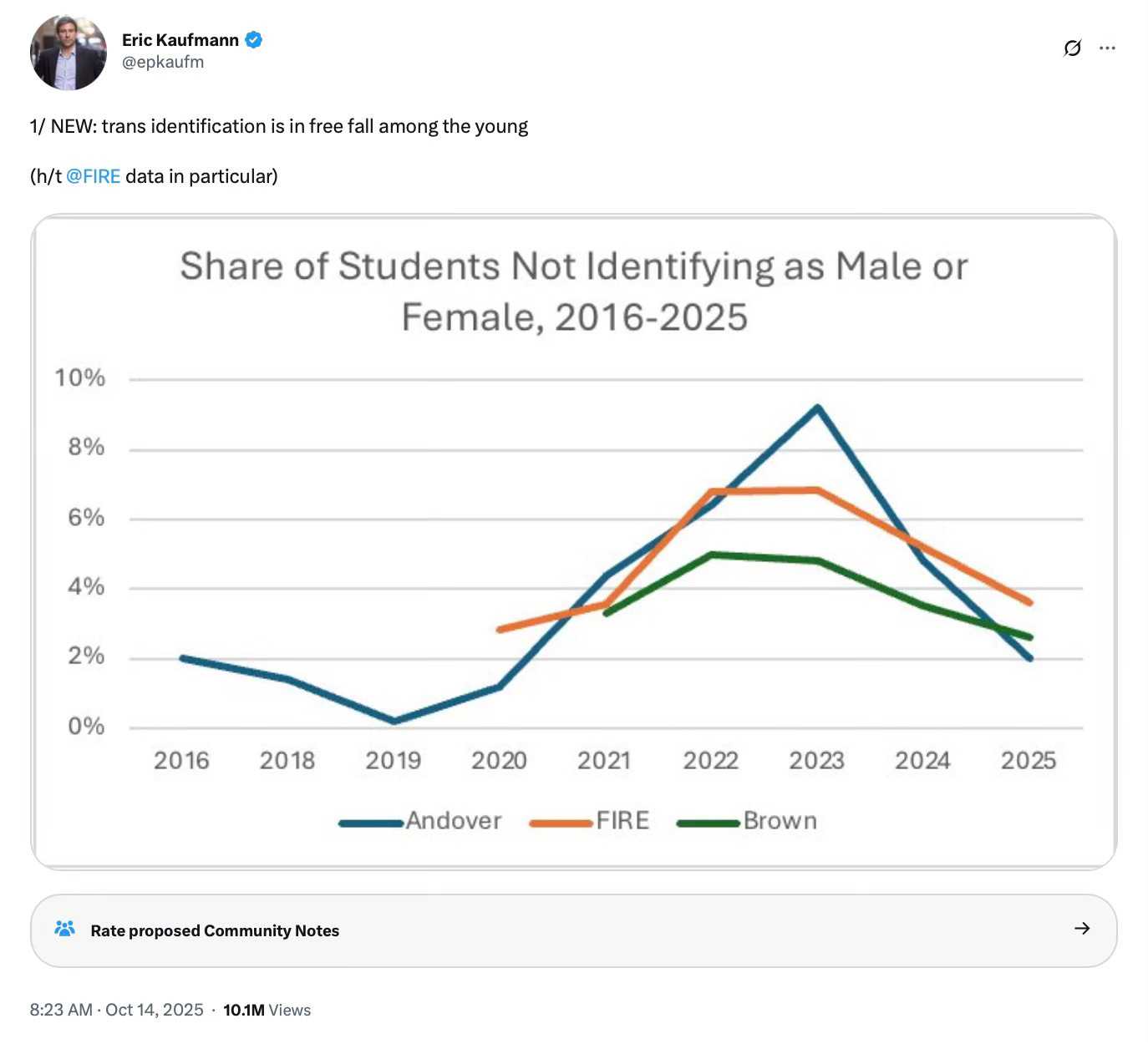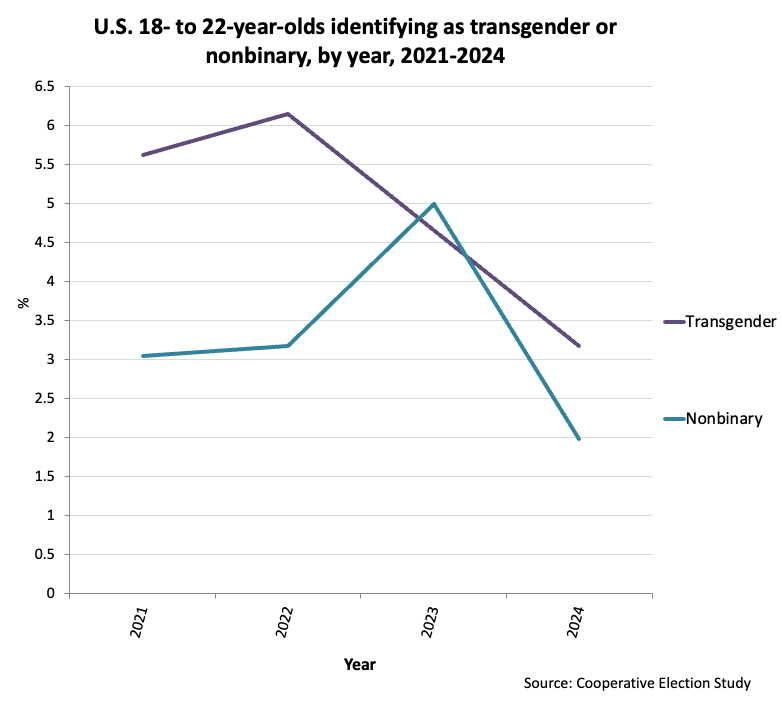The Global Gender Climate Is Changing Even If Your Local Gender Weather Still Varies
The future is already here, just not evenly distributed
“It appears that trans and queer are going out of fashion among young people, especially in elite settings”, Eric Kaufmann, Professor of Politics at the University of Buckingham, said in findings released two weeks ago. College freshmen are less likely to identify as part of the rainbow than seniors on the same campus. “To the extent that the youngest represent the leading edge of new trends, this suggests that trans, bisexual and queer identities are declining in popularity with each new cohort.”
While “the share of non-binary, bisexual and queer young people rose after 2010 and fell after 2023”, at least “part of the decline in trans identification was compositional, arising because there were fewer students with anxiety and depression in 2025 than in 2023”. Mental health simply improved, post-covid. “Trump, Biden and the ‘vibe shift’ away from woke in the elite culture appear to have had little effect on the gender and sexual identities of students”, Kaufmann concludes.
Only time will tell if the substantial decline of BTQ+ identification will continue among young Americans. If so, this represents a momentous and unanticipated post-progressive cultural shift in American society which is distinctly out of phase with the expectations of cultural left observers in educational institutions and legacy media outlets.
The news went viral after Dr. Kaufmann published a summary of his findings at UnHerd. It was generally greeted with celebration, relief, and the sense that a fad had simply passed as expected. After all, ‘trans’ was always a social contagion. Should we not expect it to wear out its welcome?
Understandably, there was relief — tempered with caution. If the young really are giving up on ‘gender identity’, “the institutions they leave behind have been intellectually and morally gutted”, as Jo Bartosch notes. There was still a lot of work left to do, even if Kaufmann was right.
But was he right? There were questions about Kaufmann’s understanding of the data. For “the surveys in question did not provide options for reporting a transgender identity”, Benjamin Ryan noted. “Instead, asked for their gender identity, respondents could say they were male, female or nonbinary. But there was no way for them to designate whether they were a trans male or trans female.”
What Kaufmann had noticed was a decline in ‘nonbinary’ identities, a subset of the larger gender fad. “It’s a shame that Kaufmann didn’t simply focus his report on nonbinary identity, given there are plenty of important discussions to be had about what the shifting trends on that front signify.”
On its own, this finding was still important. Neogenders are “the most dangerous trans identities of all because on the surface, they present the least onerous demands of all the characters in the troupe”, singer Róisín Michaux writes at her Substack. “And yet accepting their claims to have no sex — however fleeting this identity might eventually be for them — is just as insidious as pretending the dockyard transvestite has an inner female soul. It’s all the same derangement.”
Maia the Peace Poet was deeply skeptical. After all, her generation was failed by ‘the science’ before, and no quick fix seems possible to her. She was not ready to throw a victory party on the basis of Kaufmann’s flawed understanding of the data. I re-stacked this one because I thought it would be good for everyone to take a cold bath on the news until we had more information.
Guess what, we have more information. Over the weekend, Jean Twenge found more survey data confirming that both transgender and nonbinary ‘identification’ have declined among American youth. “Among 18- to 22-year-olds, trans identification was cut nearly in half from 2022 to 2024. Nonbinary identification dropped by more than half between 2023 and 2024”, she explained. Although “we can’t tell if this trend will continue”, we do seem to be past the peak of the ‘trans’ phenomenon in the USA.
So here at last is the right chart, the one that actually shows actual transgender identification actually declining in 2023 and 2024. ‘Nonbinary’ had a temporary bump in 2023 that disappeared by 2024. That makes sense given how frequently ‘nonbinary’ and other neogenders seem to be ‘halfway houses’ for adolescents working their way through gender confusion. The kids do seem to be returning to normal, their mental health improving. The obvious question is why.
Once again, Benjamin Ryan has an answer. Last year, he wrote that “Gender clinics pulled back on prescribing gender-transition treatments to minors in 2023 in all but one of the 24 states, plus Washington, DC, that have not passed bans on such medical interventions” after almost two dozen US states had passed bans in the previous year. “Pediatric gender medicine is in a nationwide retreat.” The data came from a partial survey of insurance claims by Do No Harm.
Bans on pediatric ‘gender medicine’ in half the states caused a drop in transgender identity medicalization in all the states. This was social contagion in reverse: public controversy about medicalizing ‘trans kids’ caused a drastic decrease in transgender identification among youth. Parents had less incentive to approve medicalization and more power to oppose it.
Despite the best efforts of the genderwoo activists in media and policy, cracks were appearing in the facade of ‘settled science’ with the Cass Review and the WPATH files at the same time. Public opinion shifted measurably, and shifted even more on the political left than the right, during the same period. A Pew Research Center poll earlier this year showed that 79% of Republicans and 35% of Democrats support banning pediatric sex changes, “an increase from 72% and 26% respectively in 2022.” As the opposition grew, transgender identification fell.
Again, this only describes the United States. It only describes one cohort of young Americans. Your mileage may vary depending on where you live, the specific issue, and how much policy capture has taken place. A very affirming California community will be very different from a Nashville exurb. ‘Trans kids’ could make a roaring comeback next decade unless the project is definitively and decisively defeated.
Things get even more dispiriting beyond the water’s edge. Australia is currently far worse for women than the United States. Germany has found ways to exceed the Americans in social absurdities, and Canadian prison atrocities rival the Barbie Kardashian story in Ireland for top billing at Reduxx. The UK government is still trying to figure out some way to conduct a puberty blocker experiment.
It makes sense that some countries would only be seeing more transgender identification than ever before right now, among their youth, even while it is declining in the USA. Remember, the western world imitated the Americans, not the other way around, so we should expect them to lag an American reversal, too. This chart does not actually conflict with the Cooperative Election Study chart above. It fits.

Therapist Stephanie Winn once described this phenomenon of differential change by comparing it to the spring and fall seasons, when the shifting weather patterns cause great local swings in temperature and precipitation. I don’t remember which exact episode it was, but she deserves credit for the metaphor, because global trends are complex systems of local change.
One might look at a chart and see an aggregate rise in youth transgender identification across the western world and despair, or look at the chart showing an aggregate decrease in the same phenomenon in the United States and shout huzzah, because either way the viewer of the charts will be correct. They are both true answers.
My friends in Europe working with detransitioners report greater need than ever for their services and I believe them. Other friends in the US have anecdotes about how the rising generation is skeptical of genderwoo; they say it is already passé where they live, and I believe them.
Science fiction writer William Gibson once said that the future had already happened, but it was not evenly distributed yet. When he said that, the internet was still a series of electronic bulletin boards. It had not become the “electronic superhighway” of Al Gore’s formulation. A decade of dial-up speed, followed by broadband, followed by the smart phone: this was the future being distributed to us, one stage or device at a time, and it is still uneven in different parts of the world.
The future does not belong to the ‘trans kids’, or their affirming parents, or their social enablers. The future is ‘transgender’ going out of fashion. It has not been evenly distributed, and it is nowhere near complete, but it is already here. We have a lot of work left to do. We have to be ready for it.
The Silencing Of The Gender Lambs
A theme is emerging. As the decade of ideological transgenderism dissolves, books on the topic now consistently resemble horror fiction on the subject of ‘trans kids’. Parent stories about clinics, schools, and whole communities ‘affirming’ their children on the flimsiest of ‘identity’ pronouncements have too much in common with films like









